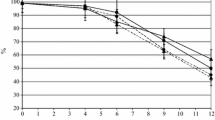Abstract
A pressing necessity of the Apulian wine industry is to be able to pilot and to control wine production to obtain wines with peculiar characteristics and with the typicality guaranteed by the denominations of origin. The employment of selected autochthonous yeast strains would be a potent instrument to improve the organoleptic and sensory characteristics of typical regional wines. In fact, indigenous yeasts are better adapted to a specific must and therefore they are able to exalt the peculiarities of the derived wine. The present work describes the genetic diversity of autochthonous Saccharomyces cerevisiae strains derived from natural must fermentations of an important Apulian grape cultivar, denoted as “Primitivo”. The yeast strains showing the best technological and oenological properties were selected, and their fermentative performances were assayed by either laboratory tests or industrial scale fermentations. Two autochthonous yeast strains were shown to be good candidates as industrial starter cultures, since they dominated the fermentation process and produced wines characterized by peculiar oenological and organoleptic features, that were judged very pleasant by a panel of winemakers.


Similar content being viewed by others
References
Alfenore S, Cameleyre X, Benbadis L, Bideaux C, Uribelarrea JL, Goma G, Molina-Jouve C, Guillouet SE (2004) Aeration strategy: a need for very high ethanol performance in Saccharomyces cerevisiae fed-batch process. Appl Microbiol Biotechnol 63:537–542
Bleve G, Grieco F, Cozzi G, Logrieco A, Visconti A (2006) Isolation of epiphytic yeasts with potential for biocontrol of Aspergillus carbonarius and A. niger on grape. Int J Food Microbiol 108:204–209
Cappello MS, Bleve G, Grieco F, Dellaglio F, Zacheo G (2004) Characterization of Saccharomyces cerevisiae isolated from must of grape grown in an experimental vineyard. J Appl Microbiol 97:1274–1280
Caridi A, Cufari A, Ramondino D (2002) Isolation and clonal pre-selection of enological Saccharomyces. J Gen Appl Microbiol 48:261–267
Esteve-Zarzoso B, Belloch C, Uruburu F, Querol A (1999) Identification of yeasts by RFLP analysis of the 5.8 S rRNA gene and the two ribosomal internal transcribed spacers. Int J Syst Bacteriol 49:329–337
Fleet GH, Heard GM (1993) Yeasts: growth during fermentation. In: Fleet GH (ed) Wine microbiology and biotechnology. Harwood, Philadelphia, PA, pp 27–55
Jackson RS (2008) Wine science. Principles and applications. Academic, Oxford
Legras JL, Karst F (2003) Optimization of interdelta analysis for Saccharomyces cerevisiae strain characterization. FEMS Microbiol Lett 221:249–255
Lopes CA, Rodríguez ME, Sangorrín M, Querol A, Caballero AC (2007) Patagonian wines: the selection of an indigenous yeast starter. J Ind Microbiol Biotechnol 34:539–546
Mallouchos A, Skandamis P, Loukatos P, Komaitis M, Koutinas A, Kanellaki M (2003) Volatile compounds of wines produced by cells immobilized on grape skins. J Agric Food Chem 51:3060–3066
Martínez-Rodríguez A, Carrascosa AV, Barcenilla JM, Pozo-Bayón M, Polo MC (2001) Autolytic capacity and foam analysis as additional criteria for the selection of yeast strains for sparkling wine production. Food Microbiol 18:183–191
Nikolaou E, Soufleros EH, Bouloumpasi E, Tzanetakisa N (2006) Selection of indigenous Saccharomyces cerevisiae strains according to their oenological characteristics and vinification results. Food Microbiol 23:205–211
Noble AC, Bursick GF (1984) The contribution of glycerol to perceived viscosity and sweetness in white wine. Am J Enol Vitic 35:110–112
Pérez-Coello MS, Briones Pérez AI, Ubeda Iranzo JF, Martin Alvarez PJ (1999) Characteristics of wines fermented with different Saccharomyces cerevisiae strains isolated from the La Mancha region. Food Microbiol 16:563–573
Pulvirenti A, Rainieri S, Boveri S, Giudici P (2009) Optimizing the selection process of yeast starter cultures by preselecting strains dominating spontaneous fermentations. Can J Microbiol 55:326–332
Ribéreau-Gayon P, Glories Y, Maujean A, Dubourdieu D (1998) Traité d’œnologie, 2. Chimie du vin, stabilisation et traitements. Dunod, Paris
Rodríguez ME, Infante JJ, Molina M, Domínguez M, Rebordinos L, Cantoral JM (2009) Genomic characterization and selection of wine yeast to conduct industrial fermentations of a white wine produced in SW Spain winery. J Appl Microbiol 108(4):1292–1302
Romano P (2005) Proprietà tecnologiche e di qualità delle specie di lieviti vinari. In: Vincenzini M, Romano P, Farris GA (eds) Microbiologia del vino. Casa Editrice Ambrosiana, p 101–131
Romano P, Suzzi G (1993) Acetoin production in Saccharomyces cerevisiae wine yeasts. FEMS Microbiol Lett 108:23–26
Sabate J, Cano J, Querol A, Guillamón JM (1998) Diversity of Saccharomyces strains in wine fermentations: analysis for two consecutive years. Lett Appl Microbiol 26:452–455
Sipiczki M, Romano P, Lipani G, Miklos I, Antunovic Z (2001) Analysis of yeasts derived from natural fermentation in a Tokaj winery. Antonie Leeuwenhoek 79:97–105
Tristezza M, Gerardi C, Logrieco A, Grieco F (2009) An optimized protocol for the production of interdelta markers in Saccharomyces cerevisiae by using capillary electrophoresis. J Microbiol Methods 78:286–291
Vincenzini M, Romano P, Farris GA (eds) (2005) Microbiologia del vino. Casa Editrice Ambrosiana, Milano
White TJ, Bruns T, Lee S, Taylor J (1990) Amplification and direct sequencing of fungal ribosomal RNA genes for phylogenetics. In: Innis MA, Gelfand DH, Sninsky JJ, White TJ (eds) PCR protocols: a guide to methods and applications. Academic, London, pp 315–322
Acknowledgements
This research was supported by a grant from the Regione Puglia Project PS_008 - INNOWINE- "Biotecnologie innovative per il miglioramento della qualità e sicurezza dei vini tipici pugliesi". The authors wish to thank Mr. Giovanni Colella for his valuable technical assistance. We would also like to thank the native speaker, Prof. H. Caffery, for proofreading and providing valuable linguistic advice.
Author information
Authors and Affiliations
Corresponding author
Additional information
This paper is part of the special issue “WINE MICROBIOLOGY AND SAFETY: FROM THE VINEYARD TO THE BOTTLE (MICROSAFETYWINE),19-20 November, 2009, Martina Franca (Italy)”.
Rights and permissions
About this article
Cite this article
Grieco, F., Tristezza, M., Vetrano, C. et al. Exploitation of autochthonous micro-organism potential to enhance the quality of Apulian wines. Ann Microbiol 61, 67–73 (2011). https://doi.org/10.1007/s13213-010-0091-7
Received:
Accepted:
Published:
Issue Date:
DOI: https://doi.org/10.1007/s13213-010-0091-7




